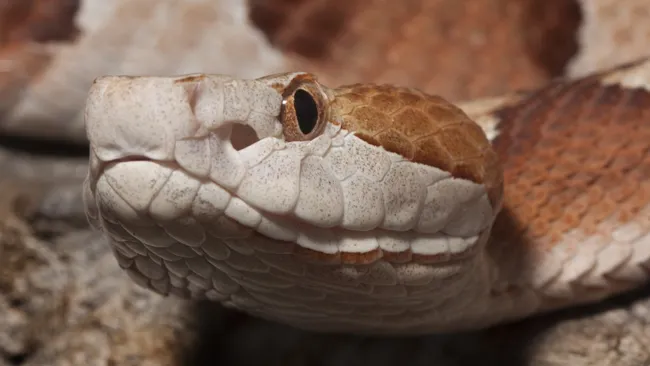Copperhead snakes, commonly found across the eastern United States, are notorious for their frequent bites compared to any other snake species in the region. Fortunately, their venom, while potent enough to cause discomfort and local tissue damage, rarely proves fatal to humans.
These snakes, scientifically known as Agkistrodon contortrix, inhabit a wide swath of territory from the Florida panhandle up to Massachusetts and westward to Nebraska. There are five recognized subspecies distinguished by their characteristic reddish-brown heads. While North American copperheads are a distinct species, various other snakes are colloquially referred to as copperheads, such as cottonmouths (Agkistrodon piscivorus), radiated rat snakes (Coelognathus radiata), lowland copperheads (Austrelaps superbus), and sharp-nosed pit vipers (Deinagkistrodon acutus).
North American copperheads belong to the pit viper family, distinguished by their heat-sensitive pit organs located between each eye and nostril. These pits detect subtle temperature variations in the environment, often signaling potential prey. Predominantly nocturnal, copperheads share behavioral traits typical of pit vipers, according to Jeffrey Beane, a herpetology expert at the North Carolina Museum of Natural Sciences.
How Do Copperhead Snakes Appear?
Physically, copperhead snakes are medium-sized, averaging between 2 to 3 feet (0.6 to 0.9 meters) in length, with females typically longer than males. Their bodies are prominently patterned with dark, chestnut-brown or reddish-brown crossbands resembling hourglasses or saddlebags against a lighter background of brown, tan, salmon, or pinkish hues. Beane describes these markings as having darker edges and lighter centers, occasionally broken or interspersed with small dark spots.
While several nonvenomous snake species exhibit similar coloration, copperheads are distinct in their hourglass-shaped markings, a key identifier for differentiating them from look-alikes in the wild.
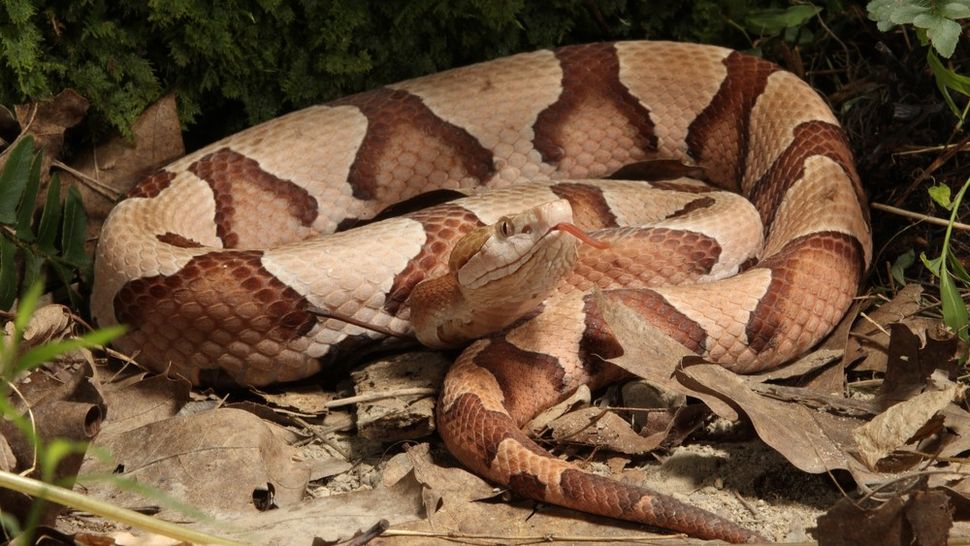
In contrast to the intricate patterns adorning its body, the copperhead snake sports a plain, coppery-brown head with only a pair of small, dark dots atop it, as pointed out by Beane. He further describes their bellies as a canvas of whitish, yellowish, or light brown hues, often dotted with prominent, paired dark spots or smudges along the sides.
Physically robust with thick, muscular bodies and keeled scales, copperheads feature heads that are triangular or arrow-shaped, distinctly separate from their necks. Beane highlights a distinct ridge that separates the head’s top from the side snout between the eye and nostril. Their pupils are vertically slit, reminiscent of cats’ eyes, while their irises typically range from orange to tan or reddish-brown.
Young copperheads exhibit a more subdued grayish coloration compared to adults, occasionally sporting bright yellow or greenish-yellow tail tips that tend to diminish in vibrancy over approximately a year, as Beane notes.
Copperhead snake bite
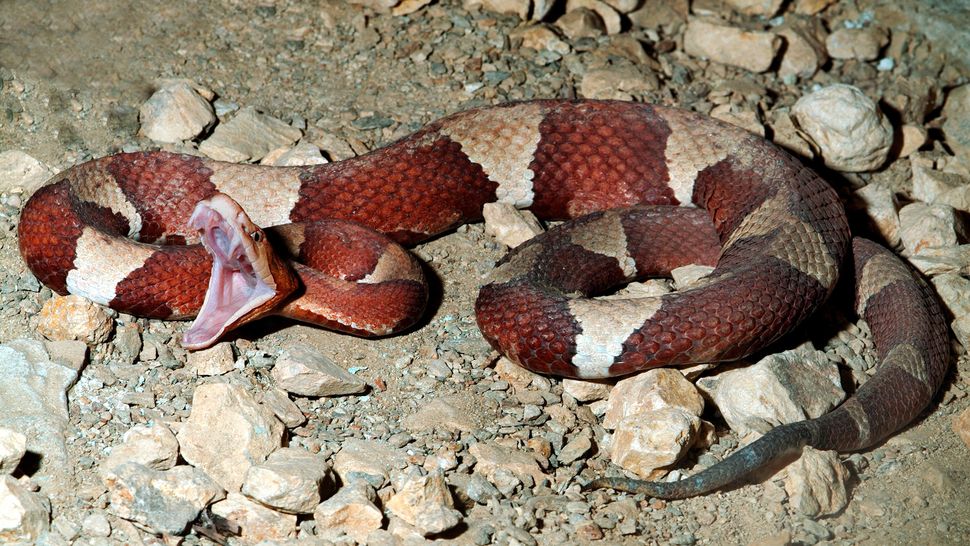
Copperheads are known to bite more people in the United States than any other snake species in most years, according to insights from the North Carolina State University Cooperative Extension Service. Fortunately, the venom of copperheads is relatively mild.
Unlike many venomous snakes that give warning signs before striking, copperheads typically do not and may strike swiftly if they feel threatened. Describing their venom as hemotoxic, Beane explains that a copperhead bite often results in temporary tissue damage near the bite site. While painful, such bites are very rarely fatal to humans. However, individuals such as children, the elderly, and those with weakened immune systems may experience more severe reactions to the venom, necessitating prompt medical attention in case of a bite.
Despite these risks, Beane advocates for coexistence with copperhead snakes in residential areas. Speaking to North Carolina’s Blue Ridge Public Radio, he notes that copperheads prefer to remain still and unnoticed when encountered, hoping to avoid conflict. If disturbed, their instinct is to retreat rather than attack. Beane emphasizes the importance of letting them reside peacefully if they are found in their preferred habitat.
Furthermore, Beane highlights the ecological benefits of having copperheads nearby. These snakes play a crucial role in controlling populations of rodents like mice and rats, which can spread diseases harmful to humans. Additionally, by consuming rodents, copperheads indirectly help reduce tick populations, which are vectors for diseases such as Rocky Mountain spotted fever and Lyme disease. Research has shown that snakes significantly contribute to controlling tick numbers in Eastern forest environments, underscoring their ecological value beyond their reputation as venomous predators.
What Habitats Do Copperhead Snakes Inhabit?
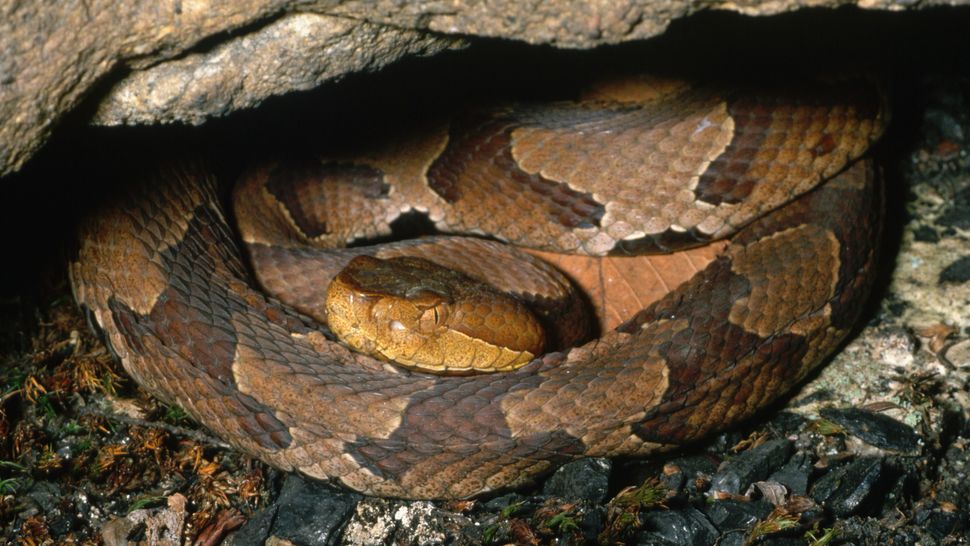
“Copperheads are found from southern New England to West Texas and northern Mexico,” as detailed by Beane, who recommends consulting range maps in various field guides for more specific geographic distributions.
There are five recognized subspecies of copperhead, each distributed across different regions: northern, northwestern, southern, and two southwestern subspecies. The northern copperhead boasts the widest range, extending from Alabama to Massachusetts and Illinois, according to information from the Smithsonian National Zoological Park.
Beane notes that copperheads thrive in a diverse array of habitats, typically preferring areas with some woodland or forest cover. They particularly favor ecotones, which are transitional zones between different ecological communities. Their habitat preferences include rocky, wooded areas, mountains, thickets near streams, desert oases, canyons, and other natural environments, as outlined by Penn State. Beane adds that copperheads are adaptable and thrive in habitats that offer both sunlight and cover.
According to the Savannah River Ecology Laboratory, copperheads exhibit a high tolerance for habitat alteration, making them well-suited to suburban environments. They can be encountered in wood and sawdust piles, abandoned farm buildings, junkyards, and old construction sites. These snakes often seek shelter under surface covers such as boards, sheet metal, logs, or large flat rocks, as Beane describes.
Copperhead snake behavior
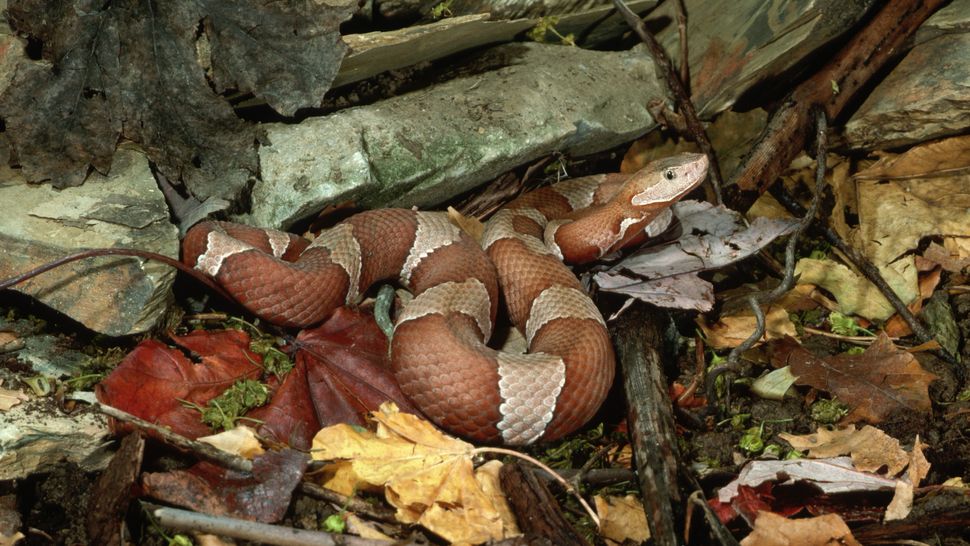
Copperheads exhibit semi-social behavior, primarily hunting alone but often hibernating in communal dens where they may return annually, according to insights from Beane. In montane forest areas, characterized by large coniferous trees below the timberline, copperheads may hibernate alongside timber rattlesnakes, rat snakes, or other species. In contrast, populations in the Piedmont and Coastal Plain regions are more inclined to hibernate individually.
The Smithsonian Zoo notes that copperheads can be observed near each other while engaging in activities such as basking in the sun, drinking, eating, and courting.
During the spring and fall, copperheads are typically active during the day, according to information from the Ohio Public Library Information Network. However, in the summer months, they become more nocturnal, favoring humid, warm nights following rain. While they usually remain ground-dwelling, copperheads may occasionally climb into low bushes or trees to hunt for prey or to sunbathe. They are also known to swim voluntarily on occasion.
According to the Animal Diversity Web (ADW), maintained by the University of Michigan Museum of Zoology, scientists have theorized that copperheads undertake late spring migrations to their summer feeding grounds, returning to their home territories in early fall.
What do copperheads eat?
Beane characterizes copperheads as “mobile ambush predators,” primarily relying on their camouflage to surprise unsuspecting prey that passes near their hiding spots. Additionally, these snakes utilize their heat-sensing pit organs to detect and hunt prey.
When targeting larger prey, copperheads employ a bite-and-release strategy, allowing their venom to incapacitate the prey before tracking it down. For smaller prey, they may hold it in their mouth until it succumbs. Copperheads consume their meals whole, using their hinged jaws to swallow prey in one gulp. According to Penn State, adult copperheads typically consume only 10 to 12 meals annually, the frequency depending on the size of the prey.
“Copperhead snake reproduction”
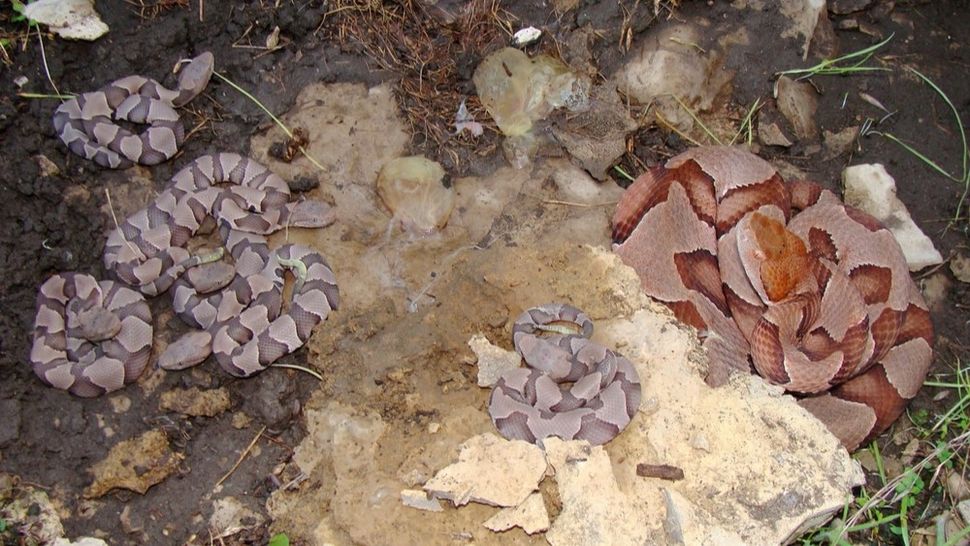
Copperhead mating season spans from February to May and from late August to October, a period marked by dramatic behaviors. According to Beane, males may engage in ritualistic combat, involving body-shoving contests, when they encounter each other in the presence of a receptive female. Penn State notes that the losers in these contests typically refrain from challenging again. Females may also participate in fights with prospective mates and are known to reject males who back down from such confrontations.
Copperheads are ovoviviparous, meaning their eggs develop and hatch inside the mother’s body, resulting in live birth. After mating in the spring, females give birth to anywhere from two to 18 live young in late summer or fall, as Beane explains. The Maryland Zoo adds that after fall mating, females store sperm and delay fertilization until after hibernation. Baby copperheads are born equipped with fangs and venom just as potent as adults, according to information from the Smithsonian Zoo.
Young copperheads measure between 8 to 10 inches (20 to 25 cm) in length at birth and possess both fangs and fully functional venom glands, notes Penn State. Their diet primarily consists of insects, particularly caterpillars.
Beane highlights that young copperheads may exhibit distinct hunting behaviors compared to adults. He describes a behavior known as “caudal luring,” where young snakes remain motionless except for flicking their yellow tail tips. This tail movement mimics the appearance of a small caterpillar or insect, potentially attracting prey such as lizards or frogs within striking range.
Classification and taxonomy of copperhead snakes
- Kingdom: Animalia
- Subkingdom: Bilateria
- Infrakingdom: Deuterostomia
- Phylum: Chordata
- Subphylum: Vertebrata
- Infraphylum: Gnathostomata
- Superclass: Tetrapoda
- Class: Reptilia
- Order: Squamata
- Suborder: Serpentes
- Infraorder: Alethinophidia
- Family: Viperidae
- Subfamily: Crotalinae
- Genus & Species: Agkistrodon contortrix
Subspecies:
- Agkistrodon contortrix contortrix (Southern copperhead)
- Agkistrodon contortrix laticinctus (broad-banded copperhead)
- Agkistrodon contortrix mokasen (Northern copperhead)
- Agkistrodon contortrix phaeogaster (Osage copperhead)
- Agkistrodon contortrix pictigaster (trans-Pecos copperhead)
Medicinal applications of copperhead snake venom
A 2018 review published in the journal Toxins highlighted that snake venom is increasingly recognized for its potential as a source of biologically active compounds that could be valuable in cancer treatment. In a significant 1999 study, scientists identified a protein in copperhead venom known as contortrostatin, which showed promise in limiting the growth of cancerous tumors.
In this study, contortrostatin extracted from southern copperheads (Agkistrodon contortix contortix) was injected into the mammary glands of mice that had previously been implanted with human breast cancer cells two weeks earlier. The results were compelling: contortrostatin not only inhibited the growth of breast cancer tumors but also slowed the development of blood vessels that nourish tumors with nutrients. Additionally, the protein prevented the spread of tumors to the lungs, a common site for breast cancer metastasis.
Subsequent research in 2013 further supported these findings by examining the effects of contortrostatin on human breast cancer cell cultures. The protein was found to significantly disrupt the structure of cancer cells and impair their ability to move and alter shape, ultimately leading to cell death.
These studies underscore the potential therapeutic benefits of exploring snake venom proteins like contortrostatin in the development of novel cancer treatments. They highlight how natural compounds from venomous animals could offer new avenues for combating cancer and improving patient outcomes.
Additional facts about copperhead snakes
Fang Length and Snake Size: The length of a copperhead snake’s fangs correlates with its overall size. Larger snakes tend to have longer fangs, which they use to inject venom into their prey.
Musk Emission: When disturbed or touched, copperhead snakes can emit a musk that has a distinct odor resembling cucumbers. This is a defensive behavior aimed at deterring potential threats.
Nickname for a Penny: In informal terms, especially in certain regions, the term “copperhead” can refer to a penny, which is a one-cent coin in the United States. This usage is derived from the historical composition of pennies, which were primarily made of copper.
Historical Term – Copperheads during the U.S. Civil War: During the U.S. Civil War, Northern Democrats who opposed the war and advocated for peace with the Confederate states were often referred to as “Copperheads.” This term, documented by the Journal of the Abraham Lincoln Association, reflects their political stance during that turbulent period.
